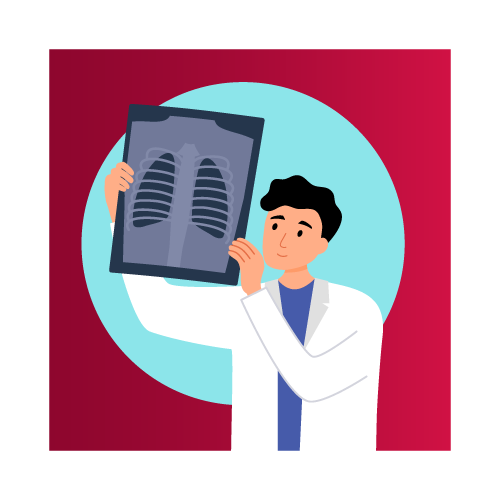
Any condition that disrupts a patient’s ability to breathe deeply and naturally is a serious health concern. Diaphragm disorders are no different.
The diaphragm is a muscle located below the lungs that helps us breathe. It contracts and flattens when we inhale and relaxes when we exhale. Any damage, or dysfunction, to this essential area can lead to breathing difficulties that impact patients quality of life.
Types of Diaphragm Disorders
There are several conditions, diseases, and injuries that can impact the diaphragm. Some of these include:
- Diaphragmatic Paralysis: This occurs when the nerve that controls the diaphragm is damaged, leading to a weakened or paralyzed diaphragm. The disorder can occur in the right or left side of the diaphragm (i.e., unilateral), or in rare cases, both (bilateral).¹
- Hiatal Hernia: A condition where a portion of the stomach bulges through the diaphragm into the chest cavity.²
- Diaphragm Eventration: A condition where the diaphragm is abnormally elevated and weakened, causing breathing difficulties.³
Causes of Diaphragm Disorders
The causes of diaphragm disorders will vary depending on several factors:
- Diaphragmatic paralysis, for example, may be caused by nerve damage resulting from surgery, injury, or viral infections.4
- Hiatal hernia can be caused by weak muscles, obesity, or age.5
- Diaphragm eventration can be congenital or due to trauma.6
Furthermore, chronic lung conditions like COPD (chronic obstructive pulmonary disease), lung cancer, or other respiratory diseases like COVID-19 can make patients more vulnerable to developing diaphragm problems.7 Additionally, neuromuscular disorders can weaken a patient’s diaphragm’s ability to function properly.8
Common Symptoms
Similar to its causes, symptoms of a diaphragm disorder will vary. Patients may experience one or a combination of the following:
- Trouble breathing
- Chest pain
- Abdominal pain
- Heartburn
- Difficulty swallowing9
In some cases, diaphragm disorders can also cause fatigue, shortness of breath, and dizziness. In more severe cases, a patient may experience respiratory failure.
 How to Diagnose Disorders of the Diaphragm
How to Diagnose Disorders of the Diaphragm
Diaphragm disorders can be diagnosed through a variety of medical tests, which may include:
- X-rays
- CT (computerized tomography) scans
- MRIs10
Additionally, pulmonary function tests may be performed to assess lung function and breathing capacity. In some cases, a diaphragm electromyography (EMG) test may be required to evaluate the function of the diaphragm muscle.
ICD-10 Code for Disorders of the Diaphragm
CASE STUDY: The Role of HFCWO in Post COVID-19 Diaphragmatic Paralysis
Research has shown that COVID-19 can lead to unilateral paralysis of the diaphragm in both acute and chronic stages.11 In a recent case study, a 51-year-old female patient diagnosed with COVID-19 experienced symptoms that included:
- Fatigue
- Shortness of breath
- Headaches
- Dizziness
The patient’s symptoms worsened after receiving treatment that included antibiotics, steroids, aspirin, and oxygen therapy. She was eventually diagnosed with paralysis of the left diaphragm and post-COVID-19 complications.
The Challenge
Despite receiving LABA/ICS and SABA inhalers for shortness of breath/wheezing and continuing oxygen therapy, the patient’s symptoms persisted and even worsened, resulting in hospitalization for pneumonia and hypoxia.
She also experienced other uncomfortable and frustrating symptoms, such as dyspnea, fatigue, dizziness, malaise, cough, weight gain, and laryngitis.
The Turning Point
After a seven month period, the patient underwent a chest CT scan and ultrasound of the diaphragm and received an algorithm of care that included oral antibiotics, a tapered dose of steroids, potassium, diuretics, and High Frequency Chest Wall Oscillation (HFCWO) therapy using The SmartVest Airway Clearance System.
Within two weeks of using SmartVest therapy, the patient reported improvement in her symptoms. Approximately 30 days later, she reported only mild fatigue and no dyspnea with or without exertion.
The Outcome
The patient, who had ongoing dyspnea and COVID-19 complications for months, had complete resolution of her symptoms within six weeks after using SmartVest twice daily.
Is SmartVest Part of Your Prescribed Therapy?
Healthcare teams can greatly benefit from adding The SmartVest Airway Clearance System to their prescribed treatment for patients in need of airway clearance.
The SmartVest system is designed to provide HFCWO therapy to help loosen and clear mucus from the lungs so patients can breathe easier. SmartVest has been proven to help reduce exacerbations requiring hospitalization, decrease antibiotic usage, and stabilize lung function.12
In fact, referring back to the case study, the patient reported experiencing a significant improvement in her lung capacity after performing HFCWO therapy. Prior to being prescribed HFCWO, she had been unable to take a deep breath without coughing or feeling her airways become restricted since her initial COVID-19 diagnosis eight months earlier.
Ready to Connect?
SmartVest allows you to provide patients with a non-invasive, effective way to manage respiratory issues and support lung function, ultimately leading to an improved quality of life.
Our dedicated clinician support team and Clinical Area Managers are available to assist you with any questions about prescribing SmartVest.
Help your patients breathe easier and find symptom relief with SmartVest. We offer a library of helpful resources. Visit our Clinician Resources page for prescription forms, tried and failed requirements, upcoming events, and additional outcomes information.
Resources
[1] National Library of Medicine.” Unilateral Diaphragmatic Paralysis.” Retrieved from https://www.ncbi.nlm.nih.gov/books/NBK557388/
[2] Cleveland Clinic. “Diaphragm.” Retrieved from https://my.clevelandclinic.org/health/body/21578-diaphragm
[3] Columbia University Irving Medical Center: “Diaphragm Eventration.” Retrieved from https://columbiasurgery.org/conditions-and-treatments/diaphragm-eventration
[4] National Library of Medicine.” Unilateral Diaphragmatic Paralysis.” Retrieved from https://www.ncbi.nlm.nih.gov/books/NBK557388/
[5] Cleveland Clinic. “Diaphragm.” Retrieved from https://my.clevelandclinic.org/health/body/21578-diaphragm
[6] Columbia University Irving Medical Center: “Diaphragm Eventration.” Retrieved from https://columbiasurgery.org/conditions-and-treatments/diaphragm-eventration
[7] Cleveland Clinic. “Diaphragm.” Retrieved from https://my.clevelandclinic.org/health/body/21578-diaphragm
[8] American Thoracic Society. “Breathing Problems in Adults with Neuromuscular Weakness.” Retrieved from https://www.thoracic.org/patients/patient-resources/resources/neuromuscular-weakness-adult.pdf
[9] Cleveland Clinic. “Diaphragm.” Retrieved from https://my.clevelandclinic.org/health/body/21578-diaphragm
[10] Northwestern Medicine. “Causes and Diagnosis of Disorders of the Diaphragm.” Retrieved from https://www.nm.org/conditions-and-care-areas/pulmonary/diaphragmatic-hernia/causes-and-diagnoses
[11] National Library of Medicine. “Unilateral Diaphragmatic Paralysis in a Patient With COVID-19 Pneumonia.” Retrieved from https://www.ncbi.nlm.nih.gov/pmc/articles/PMC8653851/
[12] Powner J, Nesmith A, Kirkpatrick DP, Nichols JK, Bermingham B, Solomon GM. Employment of an algorithm of care including chest physiotherapy results in reduced hospitalizations and stability of lung function in bronchiectasis. BMC Pulm Med. 2019;19(1):82. Published 2019 Apr 25.

